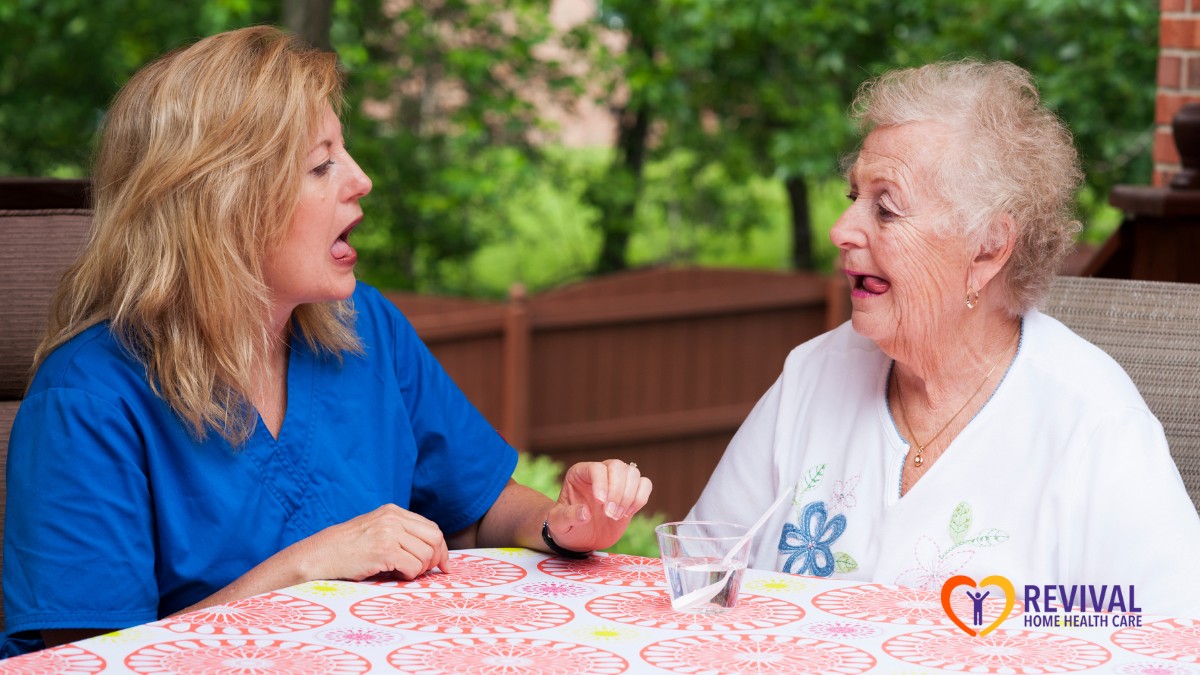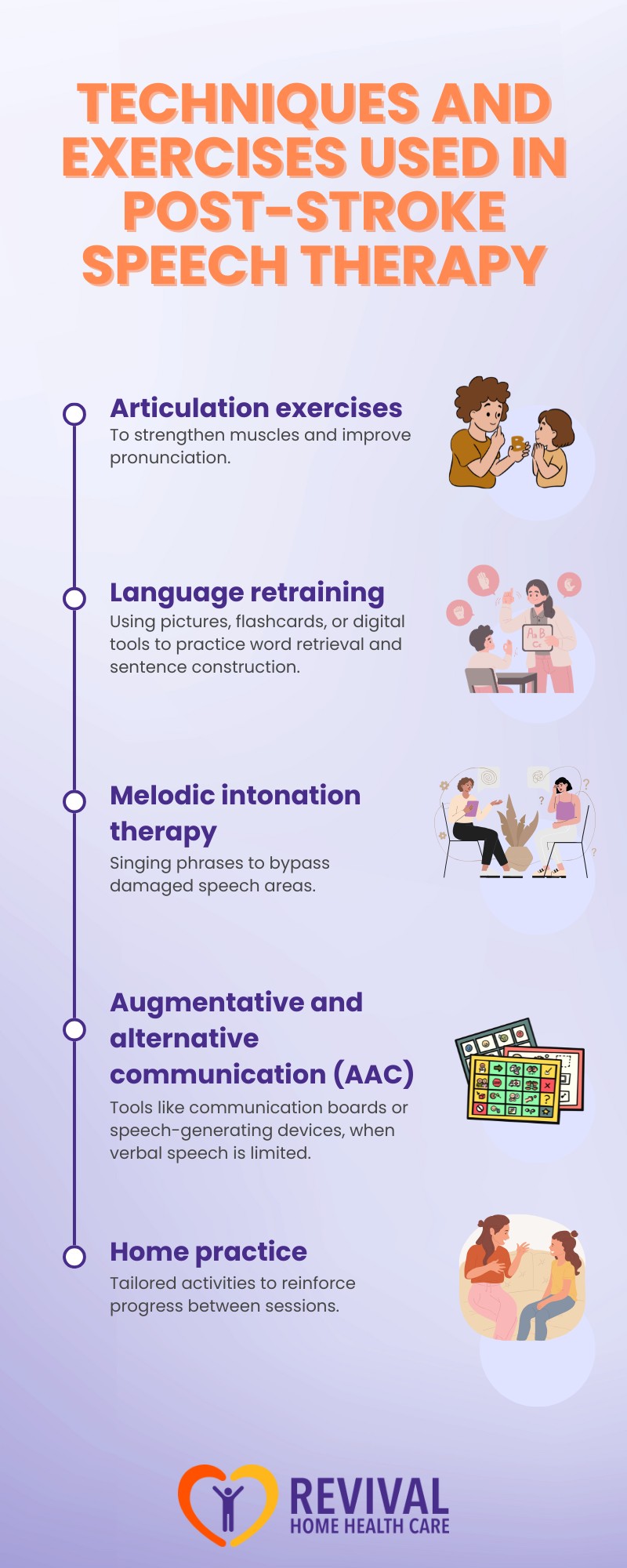Key Points:
- Stroke survivors often experience communication challenges due to aphasia, dysarthria, or apraxia.
- Speech therapy plays a critical role in helping individuals relearn and improve language skills after a stroke.
- Early intervention, personalized therapy plans, and supportive environments enhance recovery outcomes.
It’s frustrating—wanting to speak, but the words just won’t come out. Many stroke survivors and their loved ones know this feeling all too well. When communication becomes difficult, it affects not just conversations, but confidence, relationships, and independence. But there’s hope: speech therapy, often used alongside physical therapy, can make a powerful difference.
Common Speech and Language Disorders Post-Stroke
A stroke disrupts blood flow to the brain, often damaging areas responsible for speech and language. As a result, stroke survivors may face a wide range of communication issues. These difficulties are not just medical—they impact daily life, emotional well-being, and the ability to reconnect with loved ones.
Each stroke is different, and so are its effects. Some of the most common speech and language disorders include:
Aphasia
Aphasia is a language disorder caused by brain damage that affects speaking, understanding, reading, or writing. It doesn’t affect intelligence, but it makes communication incredibly difficult. There are different types, such as:
- Broca’s aphasia: trouble forming complete sentences.
- Wernicke’s aphasia: speaking fluently but with little meaning.
- Global aphasia: severe impairment in all language skills.
Dysarthria
Dysarthria results from muscle weakness that affects speech clarity. Speech may sound slurred, slow, or robotic. While the person knows what they want to say, the physical ability to articulate it is compromised.
Apraxia of Speech
With apraxia, the brain struggles to coordinate the muscle movements needed for speech. This can make speech inconsistent and effortful, even though the muscles themselves are not weak.

The Role of Speech Therapy in Stroke Recovery
Speech therapy after a stroke isn’t just about learning to speak again—it’s about reclaiming identity, reconnecting with loved ones, and rebuilding confidence. A licensed speech-language pathologist (SLP) works one-on-one with stroke survivors to target their specific communication needs.
Starting speech therapy early—ideally within days or weeks after the stroke—can lead to better outcomes. The brain is still healing during this time, and therapy can take advantage of neuroplasticity, the brain’s ability to reorganize and form new connections. However, even if months or years have passed, speech therapy can still provide meaningful improvements. Progress may be slower, but recovery is ongoing.
What to Expect from a Speech Therapy Plan
Every stroke survivor’s journey is unique. That’s why speech therapy plans are customized to each individual’s challenges, strengths, and goals. Therapy may include:
Assessment and Goal Setting
The first session usually involves a comprehensive assessment. The SLP evaluates speaking, understanding, reading, writing, and swallowing abilities. Based on this, they set realistic, meaningful goals that focus on practical communication—like ordering at a restaurant or talking to family.
Techniques and Exercises Used in Post-Stroke Speech Therapy
Therapists use a wide range of evidence-based techniques, including:

Supporting a Loved One Through Speech Recovery
Caregivers play a vital role in speech recovery. Patience, encouragement, and consistency make a huge difference. If you’re supporting a stroke survivor, here are some practical ways to help:
Create a Supportive Environment
Minimize distractions when communicating. Turn off the TV, maintain eye contact, and give the person time to respond. Speak in short, simple sentences.
Celebrate Small Wins
Progress may be slow, but every new word, phrase, or successful conversation is a step forward. Acknowledge the effort, not just the outcome.
Practice Together
Join therapy sessions when possible or ask the SLP for activities you can do at home. Practicing in familiar settings helps generalize skills to real life.
Encourage Social Interaction
Social isolation can make recovery harder. Encourage phone calls, visits, or even group sessions with other stroke survivors to rebuild confidence.
Overcoming Setbacks and Frustration
Recovery is rarely a straight path. Setbacks happen. There may be days when speech seems worse, or when progress plateaus. This is normal. Encouragement, consistency, and professional support help navigate these challenges. SLPs may adjust therapy goals or introduce new strategies if something isn’t working. Being flexible and persistent is key.
Benefits of Receiving Speech Therapy at Home
Many stroke survivors face mobility issues or fatigue, making travel to a clinic difficult. That’s where in-home speech therapy becomes invaluable, offering a convenient solution that supports both comfort and independence during recovery.
Personalized in a Comfortable Setting
In-home therapy allows the SLP to work with clients in their natural environment. This helps tailor sessions around daily communication needs—like using the phone, watching TV, or chatting during meals.
Less Stress, More Convenience
Home-based sessions remove the physical and logistical stress of commuting. This can lead to better focus during therapy and more consistent attendance.
Family Involvement
Family members are often more engaged during in-home therapy. They can learn strategies directly from the therapist, ask questions, and help reinforce practice between sessions.
Tips for Maximizing Speech Therapy Outcomes
Here’s how stroke survivors and caregivers can get the most from speech therapy:
- Stay consistent: Attend sessions regularly and complete home practice.
- Keep a journal: Track words, phrases, or challenges to share with the therapist.
- Be open: Let your therapist know what’s working or not. Therapy should evolve with your needs.
- Use technology: There are many apps that support language recovery. Your SLP can recommend the right ones.
- Practice daily: Even 10–15 minutes of focused practice can make a difference over time.
Regain Confidence and Communication—Start In-Home Therapy Today
Recovering speech after a stroke is a journey that takes time, patience, and the right support. At Revival Home Health Care, we understand how personal and emotional this journey can be. That’s why we offer in-home speech therapy in New York, bringing professional care directly to you or your loved one’s doorstep.
Our licensed speech-language pathologists specialize in helping stroke survivors regain the communication skills they need for daily life. Whether you’re navigating aphasia, dysarthria, or other post-stroke challenges, our therapy is tailored to your unique needs—right in the comfort of your own home.
Reach out today to learn how Revival Home Health Care can support your recovery with compassionate, expert care that meets you where you are.


 75 Vanderbilt Ave Staten Island, NY 10304
75 Vanderbilt Ave Staten Island, NY 10304 info@revivalhhc.org
info@revivalhhc.org 718.629.1000
718.629.1000